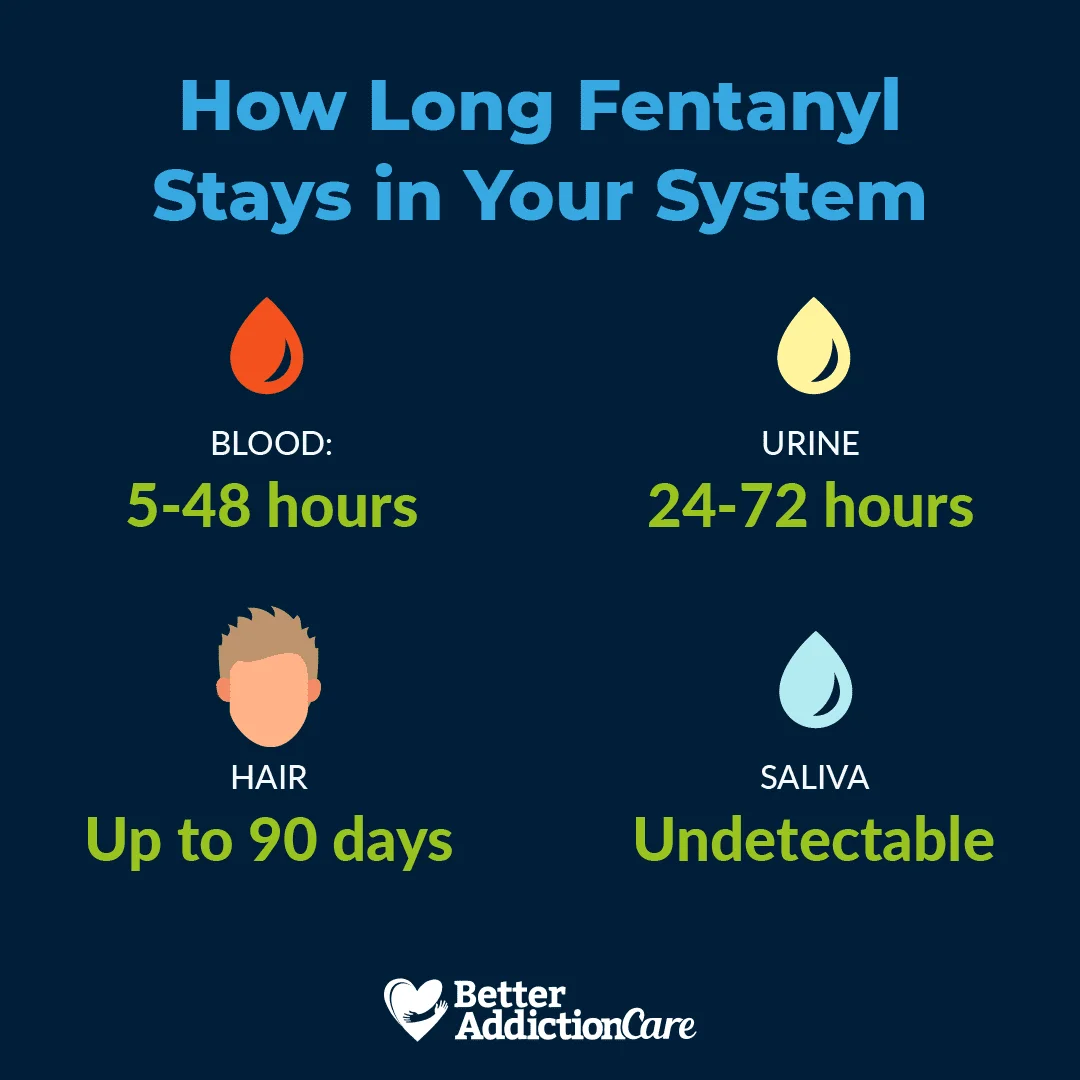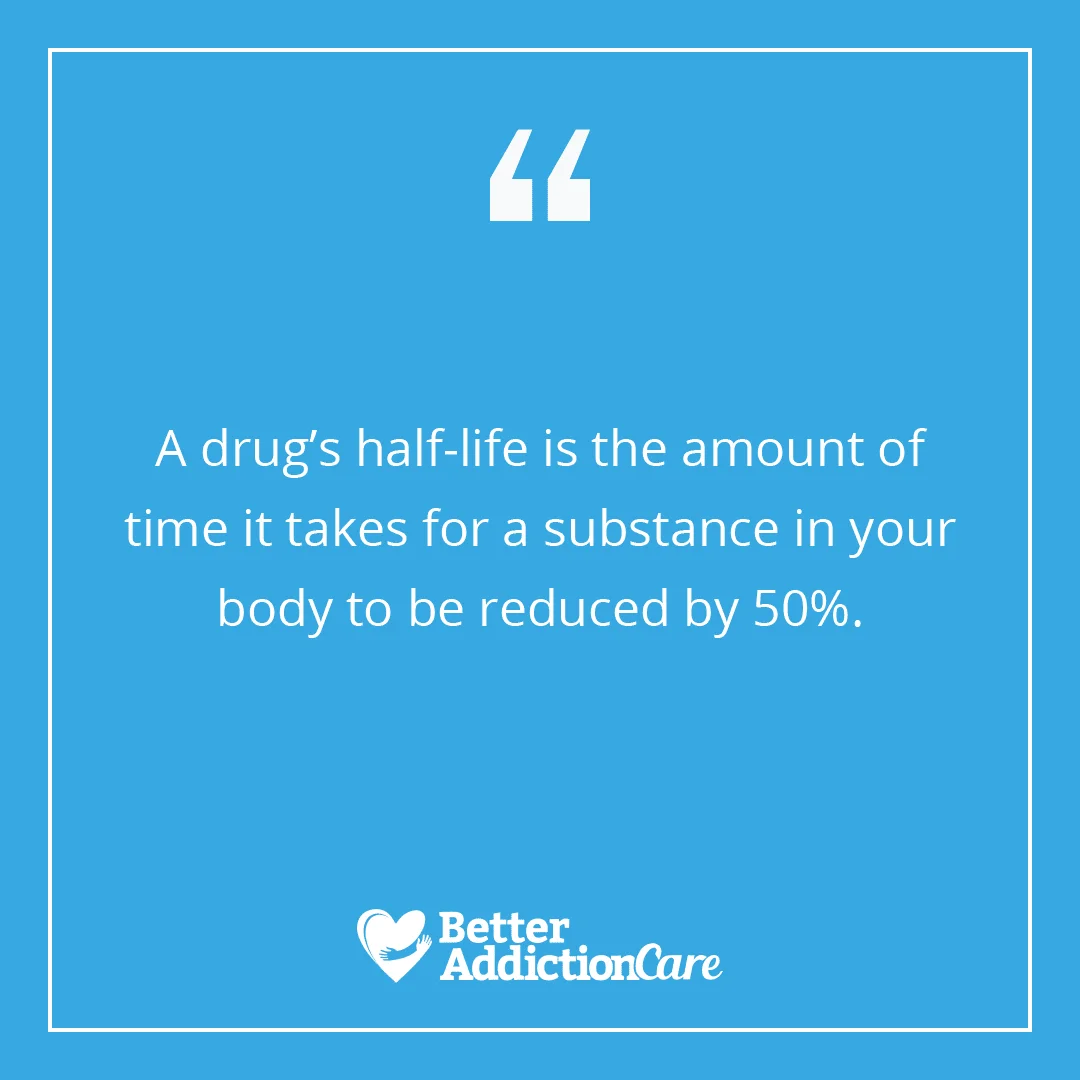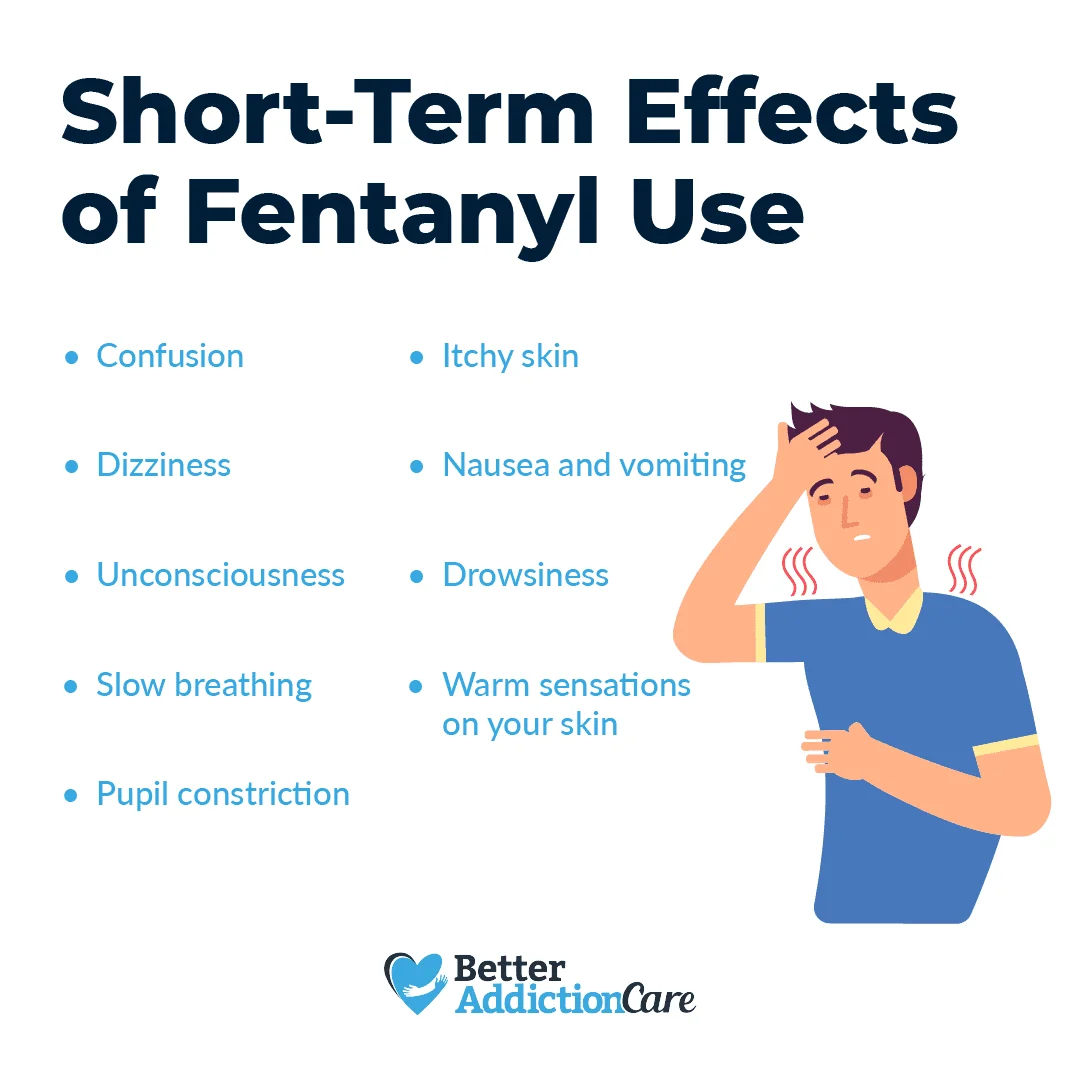How Long Does Fentanyl Stay in Your System?

Fentanyl is a synthetic opioid that’s approximately 50-100 times more potent than morphine.1 It can stay in your urine for between 24 and 72 hours but may be undetectable in your saliva.2 It may remain in your blood up to 48 hours and your hair for up to 90 days after your last use.3,4
Several factors may play a role in how long fentanyl stays in your system, including the dose used, how often it’s used, your metabolism, weight, urine concentration, and whether your liver and kidneys are functioning correctly.
How Long is Fentanyl Detectable in Drug Tests?
A drug’s half-life is the amount of time it takes for a substance in your body to be reduced by 50%.5 Different drugs have different half-lives.
Fentanyl has a half-life of 3.65 hours. Research indicates that a drug will likely be eliminated within 4-5 half-lives, which means within 15 and 18 hours for fentanyl.6 Several types of drug tests exist to detect drugs like fentanyl, including urine, saliva, hair follicle, and blood testing. Each one has a different detection timeframe discussed below.

Urine Testing
There are a couple of urine tests for drug screening: immunoassay (IA) and gas chromatography-mass spectrometry (GC-MS). While an IA test is faster and less expensive, it sometimes gives false-positive results. GC-MS can confirm an IA test’s accuracy.
Advanced urine testing can detect fentanyl between 24 hours and 72 hours after you last used this opioid.2
Saliva Testing
Although saliva tests are relatively common to test for the presence of many drugs, it is not very reliable for fentanyl. Often, saliva tests are unable to detect fentanyl or its metabolites.2
Hair Follicle Testing
Hair grows slowly and can indicate long-term drug use. A medical professional using a hair follicle test may be able to detect fentanyl in your system for up to 90 days (about three months) after your last use.3
Blood Testing
Since drugs metabolize quickly, blood tests aren’t as effective as hair or urine tests. Medical professionals may only detect fentanyl in your system for up to 48 hours after your last use.4
What Factors Affect How Long Fentanyl Stays in Your System?
Everyone has different physiology (how your body functions). Various factors contribute to how long fentanyl can remain in your system, such as:
- Your metabolism, which may depend on the state of your liver and kidneys
- The amount of fentanyl you used
- The frequency of your fentanyl use
- Height, weight, and age
- Urine concentration (pH)
- Genetics
- Method of administration
- Use of other drugs, like cocaine or alcohol
- Fentanyl tolerance
- Medical conditions that affect your ability to flush toxins out of your body
- Your level of physical activity

Can Other Substances Cause a False Positive for Fentanyl?
Yes, some substances, medications, and even foods can cause a false positive for fentanyl or other opioids, such as:7
- Poppy seeds
- Quinolone antibiotics
- Rifampin (antibiotic)
However, false positives are only typical in workplace settings, where the threshold for testing positive for opioids is much lower than in a clinical situation.7 If you believe you’ve received a false positive for fentanyl or any other drug, you can request a second drug test.
There is another type of false-positive that’s associated with fentanyl test strips, which are used by drug users to test their drugs for the presence of fentanyl in order to prevent overdose. When you are testing your drugs for fentanyl, the fentanyl test strips may give false positives when a certain amount of ecstasy/MDMA, methamphetamine, or diphenhydramine (Benadryl) is present.8 In the event of a false positive on the fentanyl test strip, there is, of course, no harm in discarding your drugs even if fentanyl isn’t really present. It’s better to err on the side of caution.
How Long Do the Effects of Fentanyl Last?
When administered via a patch (a common form of slowly releasing the drug), it can take fentanyl 24-72 hours to reach a steady state. After removing the patch, your skin will continue to absorb the substance. Fentanyl blood levels may take about 17 hours to drop 50%.9 Patients may apply new patches every three days to deal with longer-lasting pain.
Other standard methods of administration are fast-acting and typically used for easing more short-term pain. They include:
- Nasal spray
- Injections—intravenously (IV) or intramuscularly (IM)
- Tablets
- Lozenges
Moreover, if you abuse fentanyl by injecting it or snorting it, you will feel the high immediately and it will last a much shorter duration of time.
Short-Term Effects
Common short-term side effects of fentanyl use, both physical and mental, may include:10
- Confusion
- Dizziness
- Unconsciousness
- Slow breathing
- Drowsiness
- Pupil constriction
- Itchy skin
- Nausea and vomiting
- Warm sensations on your skin
Life-threatening effects, such as stopped or shallow breathing, can occur within about 2 minutes after use.10

Signs of a Fentanyl Addiction
If you are wondering how long fentanyl stays in your system or are trying to figure out how to pass a drug test, this may be a sign that you’re struggling with a fentanyl addiction. Addiction is a very debilitating condition characterized by a cycle of compulsive drug use—it often requires professional treatment in order to overcome.
According to the Diagnostic and Statistical Manual of Mental Disorders, Fifth Edition (DSM-5), the following include signs and symptoms of a fentanyl addiction:11
- Hazardous use: You repeatedly use fentanyl in a physically dangerous manner that affects yourself or others (e.g., overdosing or driving under the influence).
- Social problems related to use: Fentanyl use begins getting in the way of relationships or leads to interpersonal conflict.
- Failure to fulfill a significant role: You’ve been skipping or have reduced participation in activities where you play an essential part (e.g., going to work, picking kids up from school, or attending classes).
- Withdrawal: You may experience fentanyl withdrawal symptoms when you suddenly quit and/or take another opioid to relieve or avoid symptoms.
- A lot of time spent using: You spend much of your time trying to obtain, use, or recover from the effects of fentanyl.
- Repeated attempts to stop use or control it: You’ve made one or more unsuccessful attempts to control, cut back, or stop using fentanyl.
- Using higher amounts for longer: You’ve begun taking more fentanyl than you initially intended or have been using this opioid for a longer period than planned.
- Cravings: You have a strong desire or urge to use fentanyl.
- Psychological or physical problems: You continue using fentanyl even though you’re aware of a recurring or persisting physical or mental problem the substance likely caused.
- Giving up activities: You’ve started skipping or reducing activities that you once enjoyed in favor of fentanyl use.
- Tolerance: You experience a diminished effect of the drug due to continued use, or you gradually increase your dosage to achieve the same effects you experienced initially.
While this list is not a substitute for an assessment through a substance abuse counselor or medical professional, it can help indicate the presence of fentanyl addiction. If you have two or three symptoms, you may have a mild addiction, four or five may indicate a moderate addiction, and six or more may indicate a severe fentanyl addiction.
Find the Best Rehab
If you have an addiction to fentanyl or another drug, consider seeking rehab to help break the cycle of use so you can live a happier and healthier life. Inpatient and outpatient forms of treatments can be highly effective to help you learn coping skills, drug refusal strategies, relapse prevention tactics, sober social skills, and more.
Give us a call at 1-800-429-7690 to find a treatment program that specializes in fentanyl addiction. These programs offer individualized treatment plans tailored to your particular needs, addiction, and history.


